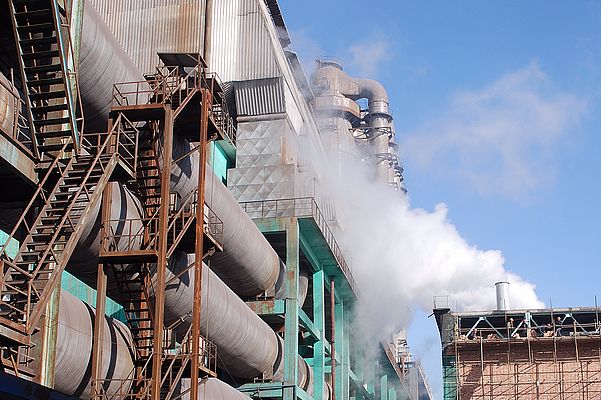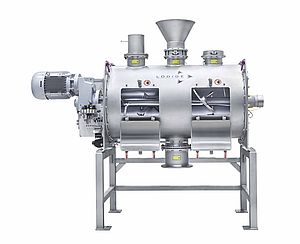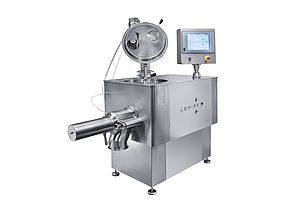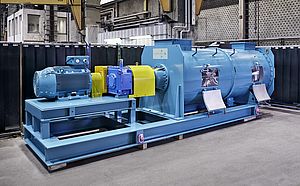The combustion of sulphurous organic substances releases sulphur oxides which are harmful to the environment and health. These compounds must be extracted from the flue gas by a suitable procedure.
Flue gases with environmentally harmful sulphur compounds (SO2 and SO3) are produced wherever sulphurous organic material is incinerated. Sulphur oxides occur in coal-fired power plants, waste incinerators or pig iron manufacturing in steelworks. Regulations require that these be removed from the flue gas. In all procedures this is achieved by the addition of a sorbent such as calcium hydroxide, sodium sulphite, ammonia, lime or pulverized limestone.
Direct desulphurization and wet process
Conventionally, flue gas desulphurization functions either by direct desulphurization or the wet process. In direct desulphurization – also known as the additive method – dry lime or pulverized limestone is introduced to the combustion chamber, where it adsorbs the sulphur compounds. The finely ground additive removes the sulphur oxides from the flue gas and binds them by adsorption to its large surface area.
The additive can be introduced at various points of the process: it is added to the fuel either prior to combustion, blown directly into the incinerator during combustion, or added to the flue gas flow. In direct desulphurization maximum 60% of the sulphur compounds can be removed from the flue gas.
In the wet process the adsorbent – likewise lime or pulverized limestone – is contained in an aqueous solution which additionally cools the flue gas mixture. The uncleaned flue gas is sprayed with the suspension, resulting in a washing solution containing calcium sulphite which is then enriched with oxygen. By the more complex wet process up to 95% of the sulphur dioxide can thus be removed from the flue gas.
The semi-dry process
The steelworks at Baotou, Mongolia, use a Lödige mixing reactor with fresh lime for flue gas desulphurization. In a power station belonging to the public utilities of Bielefeld recycled lime is used for flue gas desulphurization in a Lödige mixing reactor.
In a typical process flow the flue gas from the incinerator first enters the evaporative cooler, where injected atomized water reduces the temperature while increasing the moisture content of the flue gas. Only then is the sorption material moistened in the mixing reactor also injected. In the next step a hose filter extracts the sorbent with the surface-bound sulphur compounds from the flue gas.
With low or strongly fluctuating flue gas temperatures the addition of water must be reduced or adjusted in order to maintain a high reactivity. Due to the moistening of the sorbent the evaporative cooler may be smaller in size or even dispensed with entirely.
Mode of action
In the Lödige mixing reactor the water is evenly distributed over a large volume of mixed lime and recycled lime. This results in an even water film on all particles and thus on the entire adsorption surface. Due to the high temperature of the flue gas the water evaporates immediately. Around the sorption particles the water vapour causes a highly reactive “ambience” and SOx compounds are better adsorbed. Adsorbent in highly reactive “ambience” with the largest possible reaction surface is thus permanently available.
Even at high throughput rates the mixing reactor permits a shorter retention time and optimum balance of water and sorbent amounts. Temperature fluctuations in the flue gas can likewise be taken into account and thus optimally compensated. The sorbent is prepared in an online process: new and reactive adsorbent is thus constantly available for reaction with the inflowing sulphurous flue gas.
Conclusion
Compared to the direct desulphurization and wet process, the semi-dry process with Lödige mixing reactors offers several advantages: in the planning of new systems, evaporative coolers may be significantly smaller or even completely dispensed with. As in direct desulphurization the sorbent is introduced into the reactor with a maximum reaction surface. A water film cools the flue gas by evaporation and at the same time creates a highly reactive atmosphere in the environment of the finely ground sorbent. Preparation of the sorbent by online process ensures high long-term availability at low cost.
Flue gas desulphurization
by semi-dry process
- by Gebrüder Lödige Maschinenbau GmbH
- August 21, 2012
- 806 views























